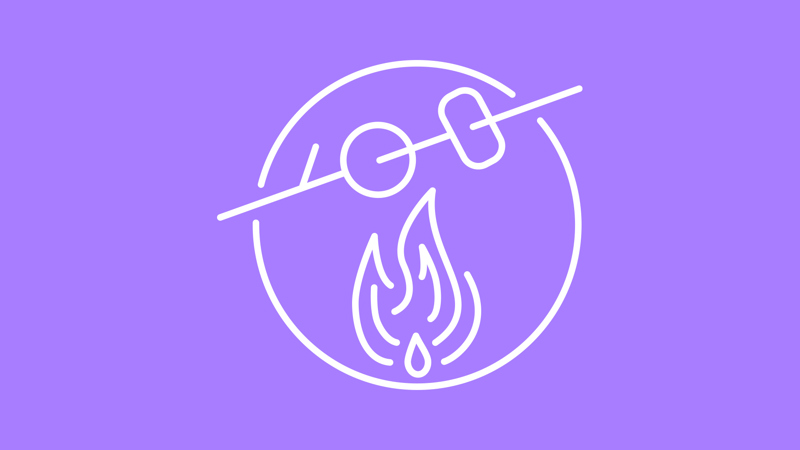
Prepare to flare
You’ll need
- Tinder (for example, cotton balls and petroleum jelly)
- Kindling (for example, small sticks)
- Firewood
- Access to water
- Matches
Backwoods cooking is the art of cooking without using pots and pans, on an open fire. This means that before you can get started with backwoods cooking, you need a good fire that gives you hot embers to cook your food.
Gather materials
- Split into three groups. The groups will collect the three types of fuel fires need to get started. One group will collect tinder, one kindling, and one firewood.
- The group collecting tinder should collect material that burns easily when lit, to start the fire. Natural materials that make great tinder include moss, wood shavings, cotton, plants, grass, fur, and dried leaves.
- The group collecting kindling should collect small sticks or twigs that will feed the fire the tinder creates. The sticks need to be dead and dry so they burn easily – they should break cleanly and crisply when snapped in half. The best sticks are from woods which contain flammable resin or oil – the group should keep an eye out for coniferous trees such as pine, spruce, fir, or deciduous birch.
- The group collecting firewood should collect larger sticks, at least as thick as their thumb. Their firewood will be the main fuel that makes sure the fire keeps burning.
Prepare your fuel
- Everyone should work together to make a natural firelighter from the tinder.
- Roll the denser materials (such as grass, plants, and moss) between your hands and form them into a large ball.
- Make a small dent in this ball, so it looks like a nest shape.
- Fill the dent with lighter materials such as wood shavings or cotton wool.
Build your fire
- Everyone should find a clear space that isn’t near any trees or bushes.
- Everyone should create a hearth (the floor of the fireplace) by putting larger sticks side by side.
- Everyone should help to use the kindling sticks to make a ‘V’ shape over the hearth sticks.
- Someone should put the natural firelighter underneath the kindling.
Light it up
- Someone should use a match to light the inside of the firelighter (the materials that fill the dent in the ball). The outer ball should help protect the flames from the wind so the tinder burns for longer.
Don’t forget to face with your back to the wind to shield the match. - Everyone should watch the firelighter burn. As it burns, the kindling should catch fire. Someone may need to blow a little on the flame to add more oxygen and help it grow.
- Everyone should help distribute the firewood over the fire bed.
Prepare to cook
Once the last flames die down, most of what’s left will be a type of fuel called white coals.
- Someone should use a stick to spread the white coals out.
- The fire is now ready for cooking. The chefs can lay a grill over the coals (resting the edges on top of logs or stones), cook food on a stick, or use a billy can to cook directly on the coals.
Extinguish your fire
- Once everyone has finished using the fire, no one should add any more wood. The fire will die down.
- Someone should use a new stick (not one that’s been in the fire) to carefully spread out the wood and embers so they cool down faster.
- Someone should pour water over the smouldering wood and ashes to make sure they’re fully extinguished. They should use the stick to mix the water through the ashes.
Reflection
This activity helped you to value the outdoors. How did you feel when you were outside building your fire? Did this activity help you feel connected to the outdoors? Were you surprised that all of the materials you needed could be found in nature? Did you manage to find everything you needed? How did you make sure the outdoors stayed safe when you were lighting your fire?
This activity was also about developing skills. You developed the skills to create an open fire for cooking an outdoor meal. What did you learn about the materials you need to start a fire? Did you get a chance to make a firelighter, or light one? Do you know how to keep yourself (and others) safe when building, using, and extinguishing a fire?
Safety
All activities must be safely managed. You must complete a thorough risk assessment and take appropriate steps to reduce risk. Use the safety checklist to help you plan and risk assess your activity. Always get approval for the activity, and have suitable supervision and an InTouch process.
- Fires and stoves
Make sure anyone using fires and stoves is doing so safely. Check that the equipment and area are suitable and have plenty of ventilation. Follow the gas safety guidance. Have a safe way to extinguish the fire in an emergency.
- Outdoor activities
You must have permission to use the location. Always check the weather forecast, and inform parents and carers of any change in venue.
- Cooking
Teach young people how to use cooking equipment safely. Supervise them appropriately throughout. Make sure it’s safe to use and follow manufacturers’ guidelines for use.
- Food
Remember to check for allergies, eating problems, fasting or dietary requirements and adjust the recipe as needed. Make sure you’ve suitable areas for storing and preparing food and avoid cross contamination of different foods. Take a look at our guidance on food safety and hygiene.
Make it accessible
All Scout activities should be inclusive and accessible.


